Electric vs Wood Sauna Stove: A Comprehensive Comparison
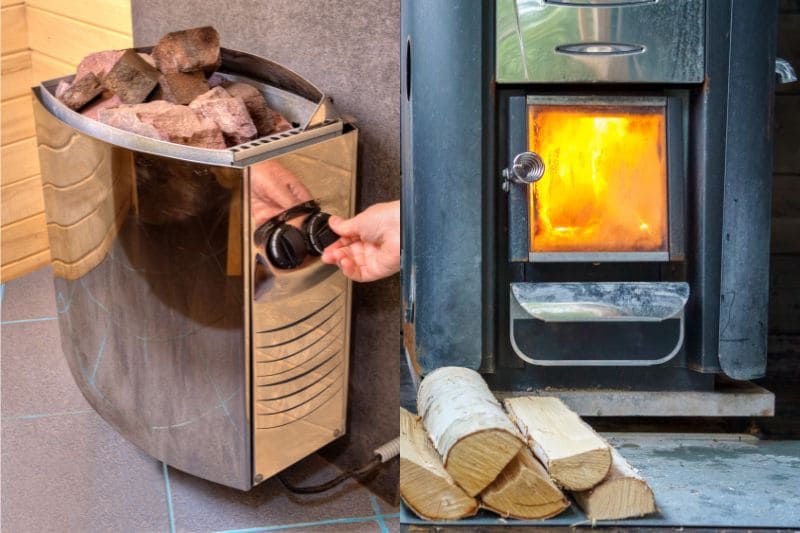
Choosing between an electric vs wood sauna stove can feel like a tough decision. Each brings its own set of perks to the table, shaping how we relax and detoxify in unique ways. This guide shines a light on those differences, offering insights you won’t want to miss.
With years of experience crafting sauna experiences for diverse needs, I’ve seen firsthand how choosing the right heater type can transform a simple room into an oasis of wellness.
Whether it’s feeling the gentle warmth of an electric heater or basking in the rich glow from wood logs, each choice has its place.
Ready to find yours? Let’s get started together.
Key Takeaways
- Electric sauna heaters are easy to use, heating up quickly with just a switch. They’re good for people who want less upkeep and fast warmth.
- Wood sauna stoves offer a traditional experience with the smell of burning wood and crackling sounds. They need more work, like chopping wood and removing ashes, but give off a deep, even heat.
- Choosing between electric and wood depends on what fits your lifestyle best. Think about installation space, maintenance effort, and whether you prefer convenience or tradition.
- Running costs can vary; electric saunas might have higher electricity bills, while wood saunas could save money if you have access to cheap firewood.
- Both types of saunas offer health benefits and relaxation but provide different experiences in terms of ambiance, aroma, and heat quality.
Table of Contents
Overview of Sauna Stoves
Sauna stoves turn up the heat and make your sauna time special. You can pick from electric ones that plug in or wood ones that need logs.
Electric Sauna Heaters
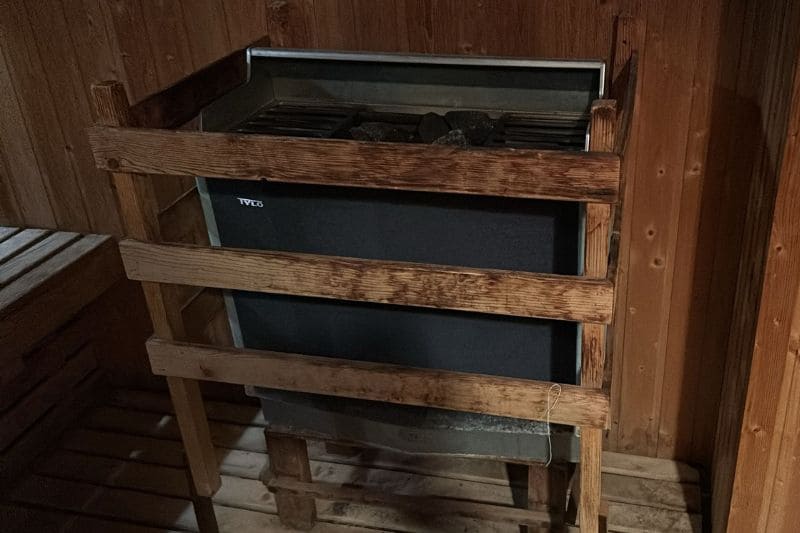
Electric sauna heaters bring the future to your home with their sleek design and easy-to-use features. Imagine flipping a switch and getting ready to relax without worrying about smoke or gathering wood.
It’s all about plugging in and chilling out. These modern marvels heat up fast, making them perfect for that last-minute decision to unwind after a long day.
I remember my first time using an electric heater in my own sauna. The ease was unbelievable. No messing with logs or matches — I just set the temperature and enjoyed the warmth spreading around me.
Plus, cleaning up was a breeze since there were no ashes or residue, just a simple wipe down now and then kept it looking new.
Electric units fit well in any room without needing major changes, which means you can enjoy the steam quicker than ever before.
To choose that perfect electric heater for your sauna which meets all your requirements, explore our curated list of the Top Performing Electric Sauna heaters in the market today.
Wood-Burning Sauna Stoves
Nothing compares to the warm embrace of wood-fired heat in a traditional sauna.
Wood-burning sauna stoves are not just any heat source; they bring a piece of tradition right into your home. Wood-fired stoves are the heart of the authentic sauna experience, echoing the earliest saunas with their crackling fires and the rich scent of burning wood.
They stand out for being cost-effective, too—usually the least pricey way to get your sweat on.
Wood stoves excel in providing radiant heat, warming you deeply and evenly. Picture loading logs into a cast iron stove or perhaps a more modern model designed for efficient burning and maximum heat output.
This method heats rocks piled on top, which then radiates that captured warmth throughout the sauna room. It’s this process that brings to life the superior steam quality—just sprinkle water onto those hot stones to enjoy an intense burst of löyly (steam), enhancing both relaxation and muscle soothing benefits.
This type does ask more from you, though: chopping wood, cleaning ashes, and ensuring proper ventilation to manage smoke. Yet many find these tasks add rather than detract from their sauna journey, making each session feel earned and, therefore, more rewarding.
All exited to find that perfect wood stove match for your sauna? Take a look at our detailed guide on the Top 5 wood-burning sauna heaters in 2024.
Electric vs. Wood Sauna Stoves: A Comparative Analysis
Choosing between electric and wood sauna stoves is like picking between a modern smartphone and a classic flip phone. Both have their charm, but they serve the user differently.
Electric sauna heaters heat up with the flip of a switch, inviting you in with consistent warmth. They’re easy to start and stop – no fuss needed.
Wood-fired sauna stoves, on the other hand, take time and skill to light up. But once they get going, they offer a warm hug that feels more natural.
The battle doesn’t stop at just turning them on or off. Electric units are great if you love convenience; plug in, set your temperature, and you’re ready to unwind. Yet for those who yearn for tradition and don’t mind some extra effort – getting your hands dirty stacking logs has its rewards.
Weighing things further… Electric models need less daily care yet can hike up your power bill over time. Wood burners require regular cleaning from ashes but might save you money if the wood is cheap where you live.
Related: Calculator for Sauna Heater Size (Most Accurate)
Heat Generation Differences
Electric sauna heaters use electric coils to generate heat. These coils heat the air and the rocks placed in or around the heater. Wood-burning sauna heaters generate heat by burning wood. The heat from the fire warms the air and the rocks stacked within or on top of the stove.
You get a quick, even warmth from electric heaters. But wood stoves give off a deep, lasting heat.
With electric types, you flip a switch, and it starts heating right away. For wood ones, you need to light a fire and wait for it to spread its warmth through the rocks into the room.
So, electric models are all about speed and ease. Wood fueled versions offer that rich, natural sensation of heat that many crave in their sauna experience.
Related: Heat up times for Different Sauna Types
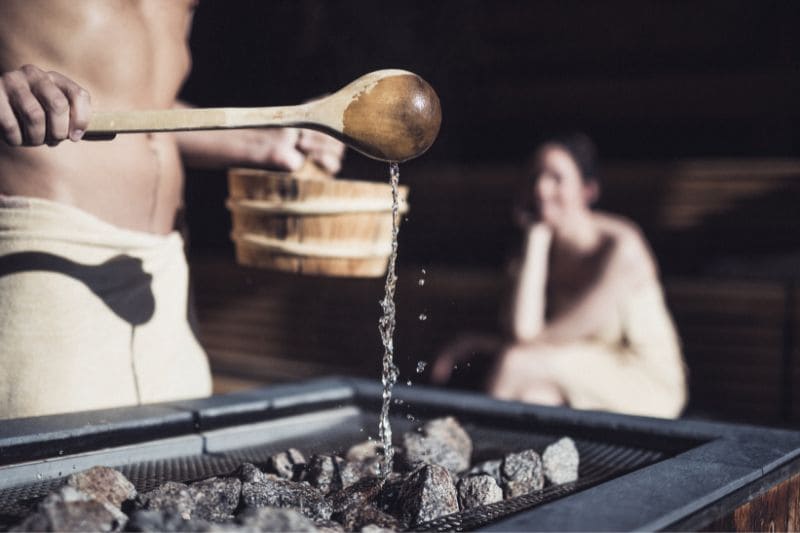
Thermal Mass and Radiant Heat
Thermal mass through radiant heat makes a big difference in how saunas feel.
In wood-fired saunas, it is common that at least one wall is made of bricks. These bricks and stones hold the heat from the fire. This warmth moves slowly into the room, warming everything it touches.
The air feels softer and more inviting because of this even spread of heat. A wood sauna’s embrace is like sun-warmed sand—gentle yet deeply comforting.
I once sat in a wood-fired sauna by a frozen lake. There, I felt the warm hug of radiant heat all around me. It was different from electric heaters that warm you directly with coils but don’t soak into your bones the same way.
Maintenance Requirements
Choosing between electric and wood saunas means looking at how much work you’ll need to do to keep them running well. I’ve spent a lot of time in both types, so I’ve got some real hands-on info for you.
Electric saunas ask for less from you in upkeep. Wood-burning ones make you work a bit more but can be worth it.
For Electric Sauna Heaters:
- Keep the heater clean – Dust off the sauna heater regularly so it works well and safely.
- Check the wiring – Every once in a while, make sure all the wires are okay and not worn out.
- Inspect heating elements – If your sauna isn’t warming up like before, you might need new heating coils.
For Wood Sauna Stoves:
- Clean out ashes – After each use, take out the ashes to keep air flowing for your next fire.
- Store wood properly – Dry wood is a must for a good fire, so keep your woodpile covered and dry.
- Chimney care – Clean your chimney regularly to avoid dangerous build-ups that can catch fire.
Common maintenance for both:
- Replace sauna rocks now and then because they break down with heat over time.
- Cleaning the seating area keeps things fresh for everyone who uses the sauna.
The next part we’re diving into is looking at all those benefits of going with an electric sauna stove.
Benefits of Electric Sauna Heaters
Electric sauna heaters make life easy. They heat up fast, so you can enjoy a steamy sauna without waiting.
Practicality and Ease of Use
Choosing between heating rocks with wood or electricity might seem like a tough choice. But, if you’re leaning towards convenience, electric sauna heaters win hands down.
They are easy to set up and start warming your sauna with just the turn of a dial. There is no need for heavy lifting or dealing with ashes afterward.
Electric heaters shine in homes because they make things simple. You plug them in, and soon after, you’re ready to relax. This ease makes them perfect for those who want a quick heat-up without extra work.
Maintenance is just as straightforward — no cleaning out ash or worrying about smoke. Just some basic checks now and then keep it running smoothly.
Convenience in Installation and Maintenance
Electric sauna stoves shine with their ease of setup and upkeep. You don’t need a big space or special tools. Most times, setting one up is as easy as plugging it in and getting cozy.
This makes it perfect for putting saunas in spots like basements without fussing over complex installations or costly setups.
For keeping things running smoothly, electric models are top-notch. They ask for very little from you—no need to sweep out ash or worry about buying wood. Just a simple wipe-down now and then keeps them ready to go.
Plus, their parts are easy to find if you ever need a fix. So, you spend more time relaxing and less time on maintenance chores.
Read our detailed expert reviews of the top electric sauna heaters this year:
- Finlandia FLB-80 Sauna Heater
- HUUM Drop 6 Sauna Heater
- Saunum AIR 7 Sauna Heater
- Vevor SCA-60NS 6kW Sauna Heater
- HUUM Cliff 6kW Sauna Heater
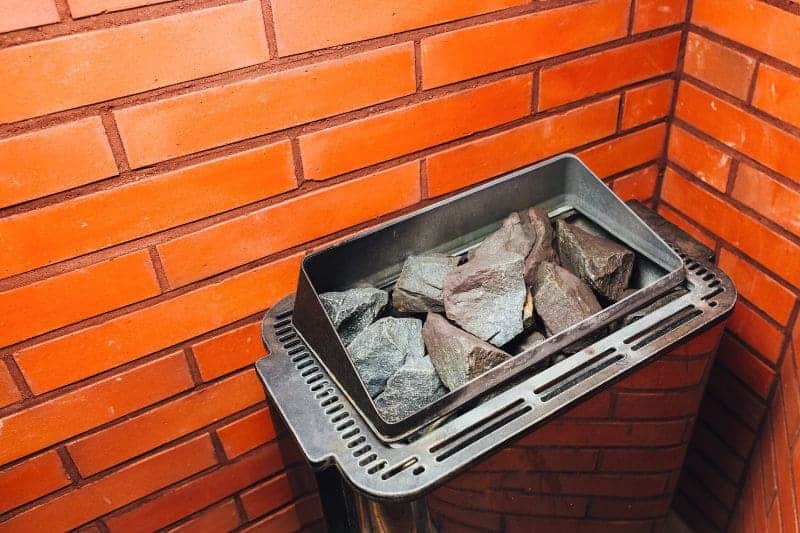
Running Costs Analysis
Keeping your sauna warm costs money. Electric saunas, for example, pull a lot more from your wallet than you might think. They need at least $1,000 just to get started. Then there’s the wiring, controls, possible panel upgrades, and let’s not forget that monthly electricity bill! Every time you enjoy a steamy session, it adds up.
I’ve crunched the numbers after switching my own home sauna from electric to wood burning. The difference was clear as day. With an electric heater, my bills were like climbing a never-ending hill – always going up.
Wood burning? More like a gentle slope in comparison. Sure, there’s the cost of wood to consider, but trust me, it doesn’t even come close to those soaring electrical fees.
Related: How much electricity does a sauna consume?
Health Benefits: Tune Your Body on Demand
Electric saunas are all about ease, but they’re also packed with some serious health perks.
They get your blood flowing better, which can chill out your blood pressure and loosen up those muscle knots.
The best part? You can dial in the perfect heat setting to max out on those detox benefits without breaking a sweat over the setup.
Benefits of Wood Sauna Stoves
Wood sauna stoves bring warmth that fills the room in a way electric ones can’t quite match. Lighting up wood and watching flames dance adds to an experience you won’t forget.
This traditional method has its perks, like getting to enjoy a rich scent only wood can provide.
Traditional Appeal and Ambiance
The traditional appeal of wood-fired sauna stoves is hard to beat. They offer a rustic feel and a unique aroma that many find appealing. The warmth from the firewood creates an inviting space, making it perfect for those who appreciate the nostalgia of classic saunas.
It’s not just about heating; it’s about enjoying a time-honored tradition that connects us with nature.
These stoves also fill the room with natural scents, adding to the sensory experience of your sauna session. Imagine stepping into a space warmed by crackling wood, surrounded by the gentle fragrance of burning timber—it’s like taking a step back in time.
This ambiance creates an authentic sauna experience far removed from modern life’s hustle and bustle.
Read our detailed expert reviews of the top wood-burning sauna stoves this year:
Superior Heat Quality
Moving from the cozy feel and look of tradition, we dive into what really makes a wood-fired sauna stand out: its superior heat quality. Wood stoves offer a heat that feels different on the skin—more enveloping and penetrating.
This isn’t just talk; it’s about how the heat travels and wraps around you. Unlike electric heaters that can have their limits, wood-burning ones let you touch high temperatures without holding back.
This kind of warmth goes deep, helping muscles relax more fully and making each breath feel like a step deeper into relaxation. It comes down to the way wood burns and releases heat slowly, keeping the air moist but not too wet.
Enhanced Sensory Experience
Wood-fired saunas bring something special to the table – or, better yet, to the air around us.
They fill the room with a rich aroma that electric ones can’t match. This smell comes from the burning wood and creates a cozy, earthy atmosphere. It feels like camping in a forest or sitting by a warm fire on a cold night.
The crackling sound of firewood adds to this sensory journey, making you feel more connected to nature and adding depth to your relaxation.
Plus, studies show that being around wood fires can even make fresh air seem fresher and boost your mood with negative ions released during combustion.
Health benefits: Deep Heat, Deeper Relaxation
Lighting up some logs and getting that fire roaring is part of the unwinding ritual in a wood-fired sauna stove. And the payoff?
A heat that sinks deep into your muscles, easing pain and making you feel all loose and limber. Plus, there’s something about the smell of burning wood that just does wonders for your soul and maybe even your sinuses.
Related: Is Sauna Good For Sinus Infection?
Influence of Sauna Heaters on the Sauna Experience

The way your sauna feels, from its warmth to the steam it makes, changes a lot based on the heater you choose. Whether it’s electric or wood-burning, each brings its own mood and heat style to your sauna sessions.
Social Aspects
The warmth of a sauna heats more than just our bodies; it warms our hearts through shared moments.
Saunas are not just places to sweat; they’re where memories heat up. Whether you choose an electric or wood sauna, the impact on social experiences is huge.
Wood-fired saunas bring a touch of tradition and a cozy ambiance, perfect for long talks with close ones. The crackle of the fire adds to the charm, making it feel like an intimate campfire gathering.
Electric saunas, on my own go-around, have made hosting easier. No need to worry about firewood or keeping the flames alive. Friends who were first-time sauna users felt at ease stepping into this modern setup. This convenience means more spontaneous sauna sessions and less planning hassle.
Both types shape how we interact but in their unique ways: one whispers tales by firelight, while the other promises effortless get-togethers.
Quality of Steam
After talking about how saunas help us bond, it’s key to look at the steam they produce. The feel of steam in a sauna changes a lot depending on if you use wood or electric heat.
- Wood-fired stoves give off steam that feels soft and gentle on your skin.
- This kind of adds to the whole vibe, making you feel like you’re in a cozy, traditional setting.
- You get this rich aroma of burning wood mixing with the steam, which many say boosts relaxation.
- On the flip side, electric heaters create steam quickly and efficiently but miss out on that traditional scent.
- They are great for getting your sauna ready fast and keeping the temperature just right without much work from you.
- This means less waiting around for things to heat up and more time enjoying the warmth.
So, choosing between wood and electric impacts not just how we heat our saunas but also defines the quality of our relaxation through differences in steam production.
Cooling Down Experience
Cooling down after a sauna feels just as important as the heat itself. It’s all about balancing your body’s temperature. Electric and wood saunas change how you cool down, but both bring the joy of relaxation.
With electric saunas, stepping out into fresh air or taking a quick shower brings your body back to its comfy state swiftly because the controlled heat inside stops right when you turn it off.
For those favoring wood fires, cooling involves more than just escaping the heat; it’s about embracing nature too.
Imagine leaving the snugness of a wood-fired sauna, your skin tingling from that unique warmth only wood can give. You might decide to plunge into cold water if you’re brave or simply stand outside, letting the cool breeze do its work.
This part – feeling the contrast between hot and cold – is essential for getting all those benefits we love: muscle relaxation and easing pains away.
Finalizing Your Choice: Electric vs Wood Sauna Stoves

Picking the right sauna heater is like choosing your favorite ice cream flavor – it all comes down to what you love most.
If you’re a fan of quick and easy, an electric sauna might just be your scoop. But if tradition warms your heart, then wood-fired could make you melt.
Lifestyle and Values Alignment
Your sauna choice reflects your lifestyle—a bridge connecting tradition with modern convenience. It’s about matching the sauna to how you live and what matters to you.
People who love tradition might lean towards wood stoves. They enjoy chopping wood and lighting the fire. This process feels authentic and connects them with nature.
On the other side, some prefer the clean simplicity of electric heaters. They find value in turning a dial and getting heat right away without extra work.
I once visited a friend’s cabin, where we fired up their wood stove sauna by a lake. The whole experience—gathering wood, watching flames catch and build, then relaxing by the water—made it clear why they chose this type over an electric one.
That day showed me how deeply personal choosing a sauna can be.
Installation and Maintenance Considerations
Choosing the right sauna heater involves a good look at both how to put it in and keep it running. Whether you sway towards the modern ease of electric heaters or lean into the rustic charm of wood burners, a few key factors come into play.
Installation
- Space Needs: Electric stoves need less space around them than wood stoves. This is because wood stoves require extra room for things like fire safety and airflow.
- Local Rules: Check your area’s rules before you pick. Some places have strict laws about what type of stove you can use, especially concerning environmental pollution due to the smoke from wood stoves.
- Power Source: For electric heaters, make sure your electrical system can handle it. They often need a lot of power to run properly. Wood stoves don’t have this issue, as they rely on logs instead of electricity.
- Venting for Wood Stoves: If you decide on a wood stove, think about how you’ll let out smoke. You’ll need a chimney or vent pipe that goes outside.
- Floor Protection: Both types need protection underneath, but in different ways. Electric ones might just need non-flammable material under them, while wood ones might require more robust floor protection due to sparks or hot ash.
Related: Can You Plug a Sauna Into a Regular Outlet?
Maintenance
- Cleaning: Wood-fired stoves demand more cleaning effort. You’ll deal with ash removal regularly and may need to clean the chimney, too, to prevent fire hazards. Electric heaters just need simple wipe-downs now and then.
- Parts Check-up: Electric models might need checks on parts like dials or PEX pipes for heat distribution if they start acting up, but generally they’re low trouble.
- Fuel Supply: For wood-burning heaters, keeping a steady supply of dry logs is crucial for smooth running—not so with electric ones, where paying the electricity bill keeps things heated.
- Hard Water Issues: In places with hard water, electric sauna heating elements might get build-up quicker which affects heating efficiency—something not faced by wood burners.
Both installation and maintenance bring their own sets of demands depending on whether you choose an electric heater or a wood burner for your sauna experience—each demanding different kinds of attention to ensure a safe and relaxing steam session every time!
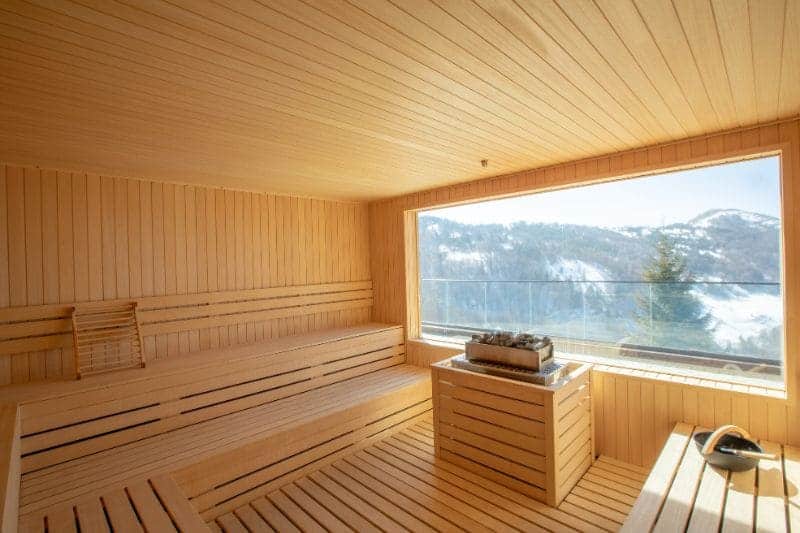
Budget and Operational Costs
Choosing between electric and wood sauna stoves affects your wallet in different ways. Let’s break down how budget and ongoing costs play a huge role in this decision.
First, consider the setup costs.
- Electric saunas need professional installation, especially for the wiring. This could add to the initial price, making them pricier than wood-fired options.
- Wood stoves might seem cheaper at first glance, but remember, you’ll also need a safe chimney system. This can add unexpected expenses.
Now, look at the running costs.
- Running a 6 kW electric heater costs roughly $1.02 per hour in the US($0.17 per kWh being the average electricity cost, as per March 2024 data). If you use your sauna four times a week for an hour each session, that’s about $16.32 a month or $195.84 yearly.
- Wood stoves have their own expenses — buying firewood regularly adds up, not to forget the time or money spent on collecting and chopping wood if you do it yourself.
Maintenance cost is another important factor.
- Electric saunas are low maintenance compared to wood-burning ones. You won’t spend much on upkeep beyond occasional checks and cleaning of the heating elements and interior.
- But with wood-fired saunas, there’s more work — cleaning out ashes, checking the chimney and flue for blockages, and possibly dealing with the smoke smell in your sauna space.
Related: Sauna Buying Guide
Environmental Impact and Sustainability: Choosing the Greener Heat
When you’re picking out a sauna, it’s not just about what warms you up best—it’s also about warming up without warming the planet too much. Let’s break down how each type of sauna stacks up on the eco-friendliness scale.
Electric Saunas: Clean Heat, Clear Conscience
Where does your power come from?
If it’s wind, water, or the sun, then your electric sauna is riding the green wave. That’s a big win for the planet, turning your relaxation time into something you can feel extra good about.
But if coal or gas powers your grid, then it’s a bit of a different story. It’s like choosing between a salad and a cheeseburger for the planet.
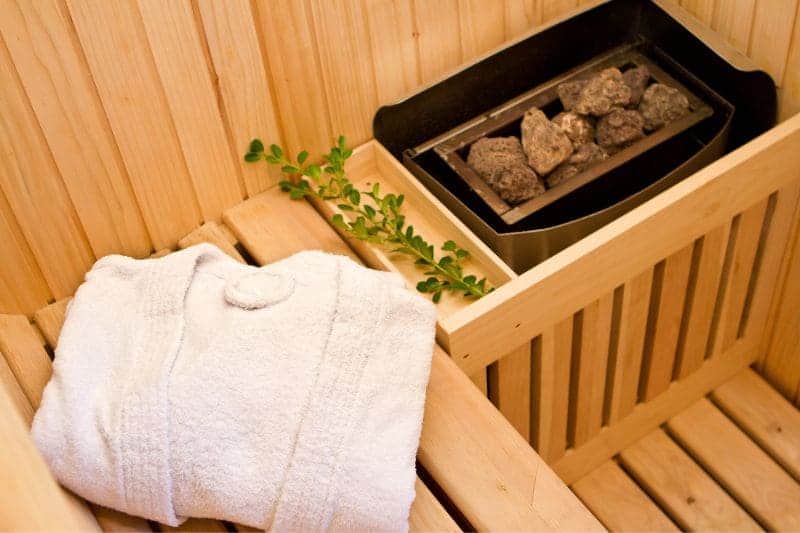
Wood Saunas: Burn Bright, Burn Right
Going old-school with a wood sauna? It’s all about the wood you’re burning.
Stick to the sustainable stuff—wood that’s cut thinking about tomorrow, keeping forests lush and lungs clean.
Today’s wood-burning stoves are nothing like your grandpa’s. They’re built to burn so clean they’d make a chimney sweep weep. Less smoke, more heat, better for your wallet and the woods.
Conclusion
Saunas warm our hearts and bodies, but choosing the right heat source can be a bit of a puzzle. Wood stoves bring that crackling charm; electric ones offer push-button ease.
Both shine in their ways – wood for its cozy ambiance, electric for sheer convenience. Think about what matters most to you. Is it the tradition and scent of burning logs? Or perhaps the no-fuss warmth at your fingertips?
Your choice reflects lifestyle desires as much as it does practical considerations like installation spots or energy costs. It might even hinge on where you live – cities nod towards electric, while countryside settings could lean to wood-burning options.
Each path leads to relaxation and health perks aplenty—a personal spa oasis awaits, shaped by your hands and heart.
FAQs about Electric vs Wood Sauna
1. What is better, wood or electric sauna?
Electric saunas are better for convenience and ease of use and are suitable for regular indoor use. Wood saunas provide a traditional experience and are ideal if you prefer a natural ambiance and don’t mind the maintenance.
2. What is the best heat type sauna?
The best heat type depends on your preference: Infrared saunas are efficient and heat the body directly for quick benefits, while traditional steam saunas use wood or electric heaters to provide a classic high-heat, high-humidity environment.
3. Are electric saunas safe?
Yes, electric saunas are generally safe when used according to manufacturer instructions, including proper installation and regular maintenance.
4. Are wood-burning saunas healthy?
Yes, wood-burning saunas are healthy, offering benefits such as relaxation and improved circulation. Ensure proper ventilation to avoid any issues with smoke.
5. Do saunas increase electric bill?
Yes, using an electric sauna can noticeably increase your electric bill, especially with frequent use, due to their high power requirements. However, infrared saunas consume very little electricity, and wood-fired ones don’t consume any.
6. What type of sauna is best for home?
The best type of sauna for home use depends on your specific needs and preferences. Electric saunas are the most convenient for indoor use, while infrared saunas offer quick heating and efficiency. Wood-fired saunas are preferable if you value tradition and have space for safe installation.

“Become a Sauna Expert Overnight!”
Grab Your “FREE” Sauna E-book NOW!
Get your hands on the ultimate sauna manual. From history to DIY setups, our free guide has it all.

As a Chartered Accountant turned sauna enthusiast, I bring a unique blend of analytical skills and hands-on experience to the world of heat therapy. With over a decade dedicated to researching and testing sauna products and practices, I’ve developed a deep understanding of this field. A the founder of HomeInDepth.com, I provide reliable, easy-to-understand information on all aspects of saunas. My goal is to guide you through every step of your sauna journey, offering meticulously researched, unbiased advice to help you make informed decisions and create your perfect sauna experience. I’m always happy to hear from sauna lovers like you—feel free to leave questions or share your own tips in the comments below so we can learn together. Contact me on:







13 Comments